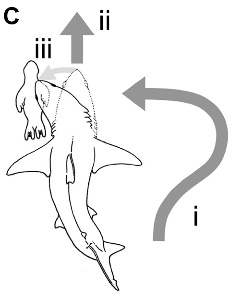Great White Shark Hunting
Mechanism
Hunting Tactics
Lateral Snap
The Great White Shark often uses a "lateral snap" strategy to grab its prey in its jaws. Although it was previously believed that the shark would approach and attack perpendicularly (i), observations of attacks and examinations of teeth marks in decoys suggest that the lateral snap method is employed when a shark is in direct pursuit of its prey. This method is probably more effective, because it allows the shark to remain swimming parallel to the seal (ii) and to strike with a movement of the head instead of the entire body (iii).

see Martin, R. A. in References
Breaching
All four inital strikes employed by Great White
Sharks involve
breaching partially or totally out of the water. Approaching from below
the seal with an accelerated burst of speed gives the shark an
advantage that is important, given that probability of a succesful hunt
is dramatically increased when the initial strike disables the seal.
Most hunting occurs when visibility is low due to low light and murky
water. The shark's advantage is enhanced in these situations because of
its low-light vision and because the seal's eyes may be outside of the
water.
Physiology
Dentition
The latero-posterior teeth and reversed intermediate teeth are curved towards each other, and hook inwards like barbs. This results in the side of the jaw producing the largest puncture wounds. The jaw is also strongest in the area between the intermediate and lateral teeth, making the lateral snap an obvious choice for effective attacks.

see Martin, R. A. in References
Musculature
More than 94% of Great White shark muscle mass is white muscle, which is good for fast movement but not sustained activity. This makes success at the initial strike more likely and more important, as fleeing seals do not tire easliy. White shark musculature is arranged in a way that is useful for performing a lateral snap.